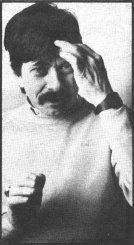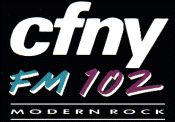Clip one: Dave Marsden opens the show with John Small, former WKNR disc jockey and discusses the various premises that were put together by WKNR in 1969 which fueled the "Paul is Dead" hoax.
Clip two: After a long on-air Beatle medley (which has been edited out here for brevity purposes), Dave Marsden follows-up immediately with a second dialogue with John Small exploring how fan and radio perception over the eventual demise of the Beatles may have contributed to the "Paul is Dead" controversy. In this interview, John Small declares that while he was participating in the "Paul is Dead" hoax, he never believed at any time that Paul was actually dead.
Clip three: In the actual CFNY-FM's radio broadcast from 1978, Dave Marsden airs WKNR's original 1969 broadcast. Album cover death clues are presented here and as Dave Marsden suggested previously, you had better get your Beatle albums out to check for the clues listed in WKNR's 1969 on-air presentation. In the second part of the show, WKNR delves into a much longer format about specific audio clues found in Beatle albums and songs. For brevity purposes, we've edited down that part of the program and have presented at least three solid audio clues for you to listen to. The first two appears in clip four and are examined by Dave Marsden and John Small, and the last one appears in clip five.
Clip four: From the WKNR 1969 broadcast, audio clues "Glass Onion" and "Revolution 9" are featured on the Dave Marsden show. After the clues are aired on CFNY-FM, both Dave Marsden and John Small do an in-depth study on how WKNR probed for the audio clues in "Revolution 9" so that their radio listeners could hear them. Dave follows-up next with his fascinating story behind the O.P.P. patch found on Paul McCartney's Sgt. Pepper outfit and the connection it made to the "Paul is Dead" controversy back in 1969.
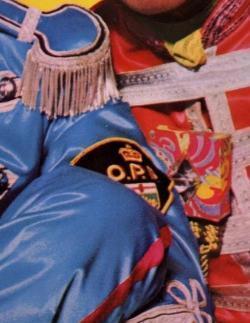
Here is the O.P.P. patch that Dave Marsden is referring to in clip four from the audio files.
Clip five: In this audio clip, Dave Marsden and John Small discusses the amount of preparation time used for the production of WKNR's "Paul is Dead" hoax. Then, after a short snippet of "Revolution 9" from the actual WKNR broadcast, the program moves on to the next clue: Back in 1969 the Lennon-McCartney song, "Ob-La-Di, Ob-La-Da", was believed to have hidden death clues if you played it backwards on your turntable. As a fan from the '69 era, this is something I would never have done to a Beatle album (hey, I "love" my Beatle albums!) but believe it or not, fans of the "Paul is Dead" myth from back then actually did this on their record players. Also in this clip, are rumors about a telephone call from Paul McCartney to WKNR which fuels even more speculation onto the "Paul is Dead" theory: Is he alive, or isn't he? Interestingly, hot on the heels of that particular telephone call, WKNR sets forth to make a determination whether it is indeed Paul McCartney's voice or not that had called in. Two approaches were then used by WKNR in making a determination: They submitted the tape for scientific analysis to Professor Oscar Tossey of Michigan State University, an audiologist and expert in "voice print method of identification." While the tape is being analyzed, WKNR decides to interview Derek Taylor by phone seeking confirmation or denial whether it was Paul who had called them up. And Derek Taylor provides them with an interesting answer, to say the least!
Clip six: John Lennon talks candidly with John Small of WKNR concerning the "Paul is Dead" rumors.
Clip seven: Derek Taylor, interviewed for a second and final time by WKNR, again attempting to explain to radio listeners that Paul is alive and well. Derek Taylor's audio comments are then examined by both Dave Marsden and John Small.
A photo of Dave Marsden, founder of CFNY Toronto, the world's first Modern Rock Radio. Dave holds a special place in the Beatles history books of being the first radio personality ever to do a live retrospective on the Paul is Dead hoax while using the actual WKNR broadcast tapes from October, 1969.
Click on the above photo to view Dave Marsden's official website!
After the initial correspondence in seeking legal permission to e-publish the above audio clips, on September 4, 2002, I decided to e-mail Dave Marsden again, this time asking him a question or two about the show. Here is the question that I had sent him:
"Dave: Who's idea was it to contact John Small of WKNR and feature the "Paul is Dead" hoax on CFNY-FM? Was this idea yours to begin with or was it your producers idea? And do you have any final thoughts about the "Paul is Dead" hoax that wasn't covered on the show?" -- John Whelan, Chief Researcher for the Ottawa Beatles Site.
And here is Dave Marsden's amazing story he sent back to me, dated September 7, 2002:
I got quite swept up in the elements, when the original story was spread about Paul being dead. Time passed. I was involved in the adventures of several radio stations - CHOM-FM and CHUM-FM - and the story disappeared. However it was always a bit of folklore that I was reminded of each time I would play a Beatle album.
In the late seventies I was doing a lot of commercials writing and producing. This was during the very early stages of my building CFNY. On one of the commercial sessions I was introduced to a guy who had previously been a DJ. His name was John Small. We got chatting about radio and all the fun stories radio people exchange when he mentioned he had been involved in the hoax about Paul McCartney's death. As you can image my ears perked up and I prepared for a wonderful conversation.
Within minutes of John beginning the story of how it all came about I stopped him. Together we decided that all of this should be shared. At that point John agreed to come on the air with me - sometime in the future.
Quite a few months passed and somehow we just never got around to getting together. As it happened we bumped into each other again and I brought up the idea of coming on the air with me. At this point I really thought John didn't want to do the show as such a long time had passed. You can image how thrilled I was when John said he'd come to the station 'TONIGHT'!
At that time CFNY was still located in the little yellow house in the middle of a field in Brampton, Ontario. That night John drove out to Brampton and we went on the air. The original studios for CFNY were in a bedroom of the old house. With soundproofing the ceilings in the room were just a little more than six feet high. John Small was a very large man and he was forced to crouch down as he entered the room. That night we huddled in the tiny studio and he told his story. There were just the two of us. I sat with turntables to my left, control console in front of me and to my right a bare wood table. Imagine that scene and then image that scene and then listen to the tale that John tells.
Ironically it was from that same studio that I also told the listeners that John Lennon had been assassinated. That's another broadcast for another time.
If I knew where John Small is today I'd have had him join me for this brief explanation of what follows. Unfortunately I do not. Also long gone is that little yellow house in Brampton. Today there is nothing left of the history that happened there but a bare spot. Today it's surrounded by strip malls and big box outlets.
Thanks for reading and thanks for listening. We had a great time doing all this stuff and it's amazing that it still lives for us to enjoy again.
David Marsden
October 12, 2003 update: Tom Zarski, then an Eastern Michigan University student and catalyst for this famous "Paul is Dead Hoax", finally speaks up! Tom's reveals his story in a publication listed at: WKNR (Keener 13.com).
April 22, 2004 update: Fred LaBour, a former junior at the University of Michigan and then an active participant in advancing the Paul Is Dead Hoax in 1969, is interviewed by Bill DeYoung, entertainment editor for TCPalm.com in an excellent article entitled: Riders' Too Slim made music history with Beatles 'clues'.
April 30, 2004 update: Radio personality extraordinaire Dave Marsden is now accessible "live" over the internet providing listeners with an excellent balance of your favorite rock tunes! You can catch the Dave Marsden show each Thursday and Friday from 7:00 p.m. to midnight (Eastern Standard Time) on "94.9 The Rock". It's really an enjoyable show, folks! Just click on this logo to enter the radio station's web site:
94.9 The Rock with Dave Marsden
Click on the CFNY-FM logo and be transported to Scott MacLean's excellent CFNY-FM Fan Site!
-----------------
Question: I've seen many video clips where John and Paul are in the United States announcing the formation of Apple records. Was Apple their idea to begin with?
Answer: No. According to Cynthia Lennon in her book, "A Twist of Lennon", Brian Epstein had the idea of creating Apple: "Public appearances stopped and Brian was in many ways left on the shelf. It seemed that he had done his bit and would have to come up with something else which would excite the boys and involve them in business with him. The idea Brian came up with was a company called Apple. His idea was to plough their money into a chain of shops not unlike Woolworths in concept - Apple boutiques, Apple posters, Apple records. Brian needed an outlet for his boundless energy. He wanted to be wanted." [page 146]. Cynthia's comments are also backed up by John Lennon: " Apple was presented to us as a reality by the Epsteins in '67 before Brian died. Brian and his furniture salesman brother, Clive." [page 248, Chet Flippo's "Yesterday: Unauthorized Biography of Paul McCartney"]. Another factor at play at this time was that the Beatles own accountants advised them that in order to avoid paying £3,000,000 in tax, that a business be created to defer that money away from the "Taxman". Thus, Brian created Apple in April, 1967. On the back cover of the Sgt. Pepper album (released on June 1, 1967), an early hint of the company name appears in the lower right-hand corner where it says: "and The Apple." The Apple logo first appeared on the inner-gatefold sleeve of the "Magical Mystery Tour" album (released on December 8, 1967). Apple's first act, Grapefruit, was signed by John Lennon on December 11, 1967.
-----------------
Question: Did John Lennon believe in God?
Answer: Yes. And in spite of the controversy over his "We're bigger than Christ" remarks that he made in 1966, John was directly asked on the question of God during his peace crusade in 1969 (the answer is found in a Rolling Stone publication -- "The Ballad of John and Yoko", page 68):
Question: "Do you believe in god?"
John Lennon: "Yes, I believe that God is like a powerhouse, like where you keep electricity, like a power station. And that he's the supreme power, and that he's neither good nor bad, left, right, black or white. He just is. And we tap that source of power and make of it what we will. Just as electricity can kill people in a chair, or you can light a room with it. I think God is."
-----------------
Question: How many world leaders did John eventually meet?
Answer: According to Ritchie Yorke, music reporter who covered John and Yoko's visit to Canada back in '69, claims that it was very important to John Lennon at the time to have been seen with a world leader such as Prime Minister Trudeau, especially in light of his campaign efforts for world peace. But John also met other world leaders too: In Julia Baird's book, "John Lennon, My Brother", Lennon met with Israel's Golda Meir. On March 19, 1964, John met Harold Wilson -- mind you, Wilson back then was Opposition Leader for the Labor Party before he became Prime Minister only a several months later. Wilson was at the Variety Club of Great Britain, held at the Dorchester Hotel, Park Lane, Central London, had presented the Beatles with silver heart-shaped award as England's "Show Business Personalities of 1963." John was also invited to U.S. President Jimmy Carter's inaugural gala in 1977 at The Mayflower (attendance was 3,500 with folks dressing more informal in fashion, including partly clad in denim.) On a side note, Beatle George Harrison along with his father, Ravi Shankar, Billy Preston and Jim Keltner chatted and had lunch with U.S. President Gerald Ford on December, 13, 1974. Later, George also had a chance meet with Henry Kissinger, not a world leader per se, but certainly a man who once welded enormous political power in his day. Henry Kissinger was 56th Secretary of State of the United States from 1973 to 1977.
-----------------
Question: Who were the first two Beatles to be interviewed for Rolling Stone magazine?
Answer: On February 10, 1968, Rolling Stone issue No. 5 contains interviews with Ringo and George.
-----------------
Question: I have a copy of the LP "Tony Sheridan and The Beatles" on the Polydor label. Can you tell me if all of those songs on track listing are performed by The Beatles?
Answer: The Beatle tracks with Tony Sheridan as produced by Burt Kaempfert, are as follows:
Cry For A Shadow;
My Bonnie;
When the Saint's Go Marching In;
Why;
Nobody's Child
These tracks were recorded on June 22/23, 1961 and were engineered by Karl Hinze in Friedrich Halle, Harburg-Hamburg. The Musicians for those tracks were: John Lennon, Paul McCartney, George Harrison, Pete Best and Tony Sheridan.
Ain't She Sweet;
Take Out Some Insurance on Me, Baby
These tracks were recorded on June 24, 1961 and were engineered by Karl
Hinze in the studio Rahistedt, Hamburg.
The musicians were: John Lennon, Paul McCartney, George Harrison, Pete Best,
Tony Sheridan.
Sweet Georgia Brown
This track was recorded on May 24, 1962 and the engineer was
Falkenburg/Sorensen in the studio Rahlstedt, Hamburg.
The musicians were: John Lennon, Paul McCartney, George Harrison, Roy Young,
Pete Best and Tony Sheridan.
GRAND TOTAL OF BEATLE SESSIONS FOR POLYDOR: 7 TRACKS.
-----------------
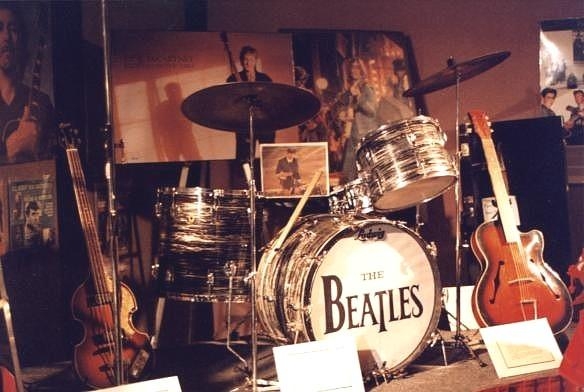
Photo credit: The Ottawa Beatles Convention, 1995, from the Alan Chrisman collection, event organizer. Used with permission.
-----------------
Question: Were Swan and Tollie records the first music company in America approached by Transglobal to distribute Beatle records?
Answer: No. On the issue on how Transglobal attempted to get the Beatles music into the USA marketplace, here is what Bruce Spizer wrote in his book, "The Beatles Records on Vee-Jay":
"George Martin was furious with EMI and Capitol and remembers getting a curt reply from Capitol that the label did not think the Beatles would do anything in the American market. Transglobal was directed by EMI to find a company to release the new Beatles single. Livingston and Marshall confirm that Transglobal tried unsuccessfully to place the Beatles with several companies. According to Livingston, "they sent them to Decca, RCA, Columbia, A&M and every record company they could get to. They got to them all, and every one of them turned them down." [Spizer, page 206, published by 498 Productions].
-----------------
Question: In 1966, was there ever any protest by Canadian politicians about the Beatles receiving their MBE's in England?
Answer: Yes. In his book, "The Boys From Liverpool" by Nicholas Schaffner (published by Methuen, Inc., 1980), states the following: 'Even so, about a dozen of the queen's most distinguished subjects sent back their own medals in a huff as soon as they heard about the Beatles' getting them. Paul Pearson, a former Royal Air Force squadron leader, claimed he did so "because it had become debased." A Canadian politician said he no longer wanted his MBE because it "put him on the same level with vulgar nincompoops." John [Lennon] replied that most of the complainers had earned their medals "for killing people. We received ours for entertaining people. I'd say we deserved ours more. Wouldn't you?"' [Schaffner, page 53].
-----------------
Question: Did Capitol and EMI records ever release a Beatles' album simultaneously around the world?
Answer: No. The first group to have released an album simultaneously around the world was done by a Canadian group called "Klaatu" who sounded very much like Beatle-wanna-be impersonators! By the way, their big hit single, "Sub-Rosa Subway" is very Beatley influenced.
-----------------
Question: George Martin seems like a pretty straight-laced record producer. Was he always this way when he worked with the Beatles?
Answer: No and don't let Sir George Martin's refined gentlemanly behavior fool you! Sir George Martin has demonstrated in the past that he can be, depending on what the circumstance is, behave in a very off-beat way. For example, Sir George Martin actually streaked around in the buff during a recording session with the Beatles. This fact was documented during a question and answer session during a Canadian Broadcasting Corporation's presentation of the Pamela Wallin show on March 5, 1998 when Sir George was promoting his farewell album, "In My Life". Here is the excerpt from the C.B.C. broadcast:
Pamela Wallin: "Is this true a story, I guess? I am shocked and appalled, sir, to find this out that there was suppose to be a party scene -- a party noise in the back of which album? I'm not sure which album -- that you weren't liking the sounds in the studio and so you stripped down and streaked them in a sense to get the real party scene" [at this point as Pamela begins to see George Martin begin forming a full grin on his face, she immediately stops her question and begins herself, to chuckle...]
Sir George Martin: [George Martin -- now chuckling out loud].
Pamela Wallin: [Pamela breaks in over George's chuckle] "I can tell by that look [on your face] that it's true!
Sir George Martin: "We did have fun. Oh, yeah...I mean, we did have a lot of laughs in the studio, there's no doubt about it and that was one of them."
-----------------
Question: I'm a little confused as to what nick-names were identified to which rock stars in the Traveling Wilbury line-up. Could you please tell me who's who in the group's line-up?
Answer: The official line-up are as follows: Bob Dylan is Lucky Wilbury; Jeff Lynne is Otis Wilbury; Roy Orbinson is Lefty Wilbury; George Harrison is Nelson Wilbury; and Tom Petty was Charlie T. Jr. That was the official line-up for the album. However, they did have a nick-name for one of their special back-up studio musicians: Jim Horn was dubbed "Sidebury Wilbury" [source: The Pet Sounds Session box set, Capitol Records].
-----------------
Question: Who did the photographic shoot for the Abbey Road album cover?
Answer: Only one photographer was involved and that was Iain Macmillan.
-----------------
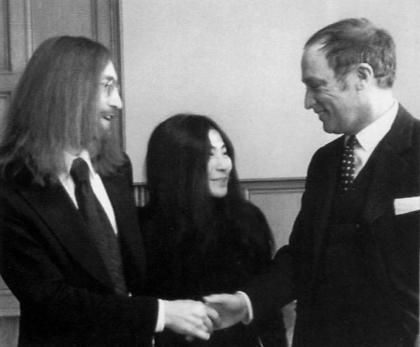
John and Yoko meet with Prime Minister Pierre Elliot Trudeau, December 23, 1969
Photo credit: National Archives of Canada (NAC-PA-110804), copyright December 23, 1969. All rights reserved and is used with permission from the National Archives of Canada. The photo is also found in the "Trudeau Years", a book published by Penguin Books Canada Ltd., in 2000.
Question: Did John Lennon ever testify to a government committee concerning substance abuse?
Answer: Yes. On file at the Ottawa Public Library and at the National Archives in Ottawa is a paper called the "Final Report of the Commission of Inquiry into the Non-Medical Use of Drugs" (whose previous working title before that was: the "Le Dain Commission of Inquiry Into the Non-Medical Use of Drugs") and is 1,148 pages long. When John Lennon visited Montréal in December 22, 1969, he presented his viewpoints before the Commission of Inquiry which helped shaped the final report. John Lennon's name and address appears on page 1113 and is credited as a "Consultant" along with the long list of other prestigious experts who testified before the Commission. The Le Dain Commission (according to the final report) received over 1,400 submissions between 1969 to 1973 before it was printed in December of that year. The publication included a lyrical quote from "I Found Out", a solo recording that John did with the Plastic Ono Band.
Exhibit 1: Lennon being acknowledged in the Le Dain report is found on 1113. Please click on the Canadian flag to view the exhibit.
Exhibit 2: Lennon's lyrics are found in the Le Dain report on page 226. Please click on the Canadian flag to view the exhibit.
-----------------
Question: In the Beatles Anthology Special Features DVD, following-up on a comment from Paul that "Golden Slumbers" was based on an old [English] lyric, George Harrison credits Arthur Askey who wrote the poem. Is George correct in crediting Arthur Askey as the poet?
Answer: No. "Golden Slumbers" was written by Thomas Dekker. Here is a brief bio on Dekker as it appears on pages 440-441 in "An Anthology of Verse" published by the Toronto Oxford University Press in 1964: "Dekker's many plays, poems, and tracts present a vivid picture of contemporary London. Although he suffered from poverty and was imprisoned for debt, his works, which express his sympathy for the poor and oppressed, are marked by a sunny simplicity." The precise date of Dekkers birth and death are not known but it is believed he lived sometime from 1570 to 1632. Here is the original lyrics that inspired Paul to slightly alter Dekker's words to fit his own song:
Golden Slumbers
Golden slumbers kiss your eyes,
Smiles awake you when you rise.
Sleep, pretty wantons, do not cry,
And I will sing a lullaby.
Rock them, rock them, lullaby.
You are care, and care must keep you;
Sleep, pretty wantons, do not cry,
And I will sing a lullaby:
Rock them, rock them, lullaby.
-- Thomas Dekker
George was always a big fan of comedians. Arthur Askey was one of them and he was certainly not a poet. Arthur Askey was known for his "treasure-chest full of catch-phrases....His facility for making people laugh soon led him to the world of concert parties and piers and he had become a top seaside entertainer by 1926." In 1938, a radio show called Band Wagon, featured Arthur Askey's radio debut which spun a film in 1939 by the same title as the radio show. "Bees in Paradise", released in 1944, was a very disappointing film for Askey and so for a whole decade the comedian did not involve himself in the cinema. [Source: britmovie.co.uk]
-----------------
Question: What are the significant Canadian tour dates that the Beatles did?
Answer: The Beatles, including John and Yoko, and George Harrison itinerary to Canada are as follows:
1964 August 18 - Brief refueling stop for the plane that the Beatles were traveling on at 2:05 p.m. in Winnipeg, before arriving in San Francisco, for a concert at the Cow Palace. The 25 minute stop-over allowed a chance for all four Beatles to be interviewed by Bob Burns of CJAY-TV. Of all the four Beatles interviewed, Burns says Ringo was the only one who took the questions seriously.
1964 August 22 - Empire Stadium, Vancouver, first concert in Canada.
1964 September 7 - Maple Leaf Gardens, Toronto.
1964 September 8 - Forum, Montréal. Nine days after this concert the Beatles are paid a then world record fee of $150,000 U.S. for a single concert in Kansas.
1965 August 17 - Maple Leaf Gardens, Toronto, the Beatles perform two shows.
1966 August 17- Maple Leaf Gardens, Toronto, the Beatles perform two shows. Other significant happening during their stopover in Toronto: John Lennon publicly encourages Americans to move to Canada if they wanted to avoid fighting in Vietnam and expressed admiration for those who had resisted the U.S. draft.
1969 February 28 - George Harrison arrives in Ottawa to critique folk singer Eric Anderson as a possible artist to sign up for their Apple records label.
1969 May 25th - John and Yoko fly to Toronto and then on to Montréal, arrive on the 26th and begin their eight day bed-in for peace in room 1742 of the Queen Elizabeth Hotel.
June 1st - John and Yoko record "Give Peace A Chance" while still sitting in bed.
June 3rd - John and Yoko travel to Ottawa University for a conference on peace.
1969 September 13th - Varsity Stadium in Toronto. With only 36 hours notice John assembles the Plastic Ono Band with Eric Clapton, Klaus Voormann, Alan White and flies to Toronto to perform his "Live Peace In Toronto" concert. Acts included Little Richard, Chuck Berry and Jerry Lee Lewis.
1969 December 16th - John and Yoko arrive at Toronto's International Airport.
- The Lennons purchase ads on billboards in several large cities proclaiming "War Is Over! If You Want It - Happy Xmas from John and Yoko." One of the billboards they used was located in Toronto.
- The couple stays at Ronnie Hawkins farmhouse not far from the city and begin an intense peace campaign. During his stay, John records a two-sided promo disc for Ronnie Hawkins' record "Down In the Alley," "John Lennon on Ronnie Hawkins."
December 17th - John and Yoko announces a press conference for peace at the Ontario Science Centre, the Music and Peace Conference of the World to be held on July 3-5, 1970. John's announcement was covered the next day by Toronto's Globe and Mail under the heading: "Lennon plans peace festival at Mosport in July". The proposed Mosport concert was later cancelled in February, 1970.
December 20th - John meets with Marshall McLuhan at the University of Toronto's Department of Culture and Technology.
December 22 - John and Yoko travel on the Rapido* train from Toronto to Montréal. This one-day visit to Montréal does herald two busy activities for the Lennons: the couple held a special press conference at the Chateau Champlain Hotel. John and Yoko also provide their drug testimony to the "Le Dain Commission of Inquiry into the Non-Medical Use of Drugs" in a railway car (possibly the Rapido they had traveled on) at the Canadian National Railway station. Two commissioners from the "Le Dain Commission", Ian Campbell and the late Hienz Lehmann, interviews the Lennons. Curiously, the Montréal media never caught on and reported this day or the following day about John and Yoko testifying at the "Le Dain Commission", perhaps if only because it was regarded as a "private testimony" to begin with.
December 23rd - In Ottawa, John and Yoko meet with Prime Minister Trudeau for 51 minutes. Present throughout the meeting is Trudeau's Executive Assistant, Timothy Porteous. When the meeting concludes, John talks to the press and states: "If all politicians were like Trudeau there would be world peace." The couple also meet with Health Minister John Munro where they have a 1½ hours chat on drugs and other topics important to the Beatle. John Munro was responsible for initiating the "Le Dain Commission of Inquiry into the Non-Medical Use of Drugs", thereby making this visit from John and Yoko, a very important one to the Health Minister.
The couple departs from Ottawa by plane and heads back to Toronto with Ronnie Hawkins on board. Ronnie informs the Lennons that Lester B. Pearson, former Prime Minister of Canada and Noble Peace prize recipient, is also on the same plane. Lennon thanks Pearson for his past peace initiatives. From Toronto, both John and Yoko heads back to England on this date. The Lennons departure from Toronto was confirmed in a news story the following day by the Globe and Mail.
* A photo of the "Rapido" train can be found in the book: "Imagine John Lennon" by Andrew Solt and Sam Egan on page 157 (by Penguin Books). The photo is from the "Ritchie Yorke" archives.
